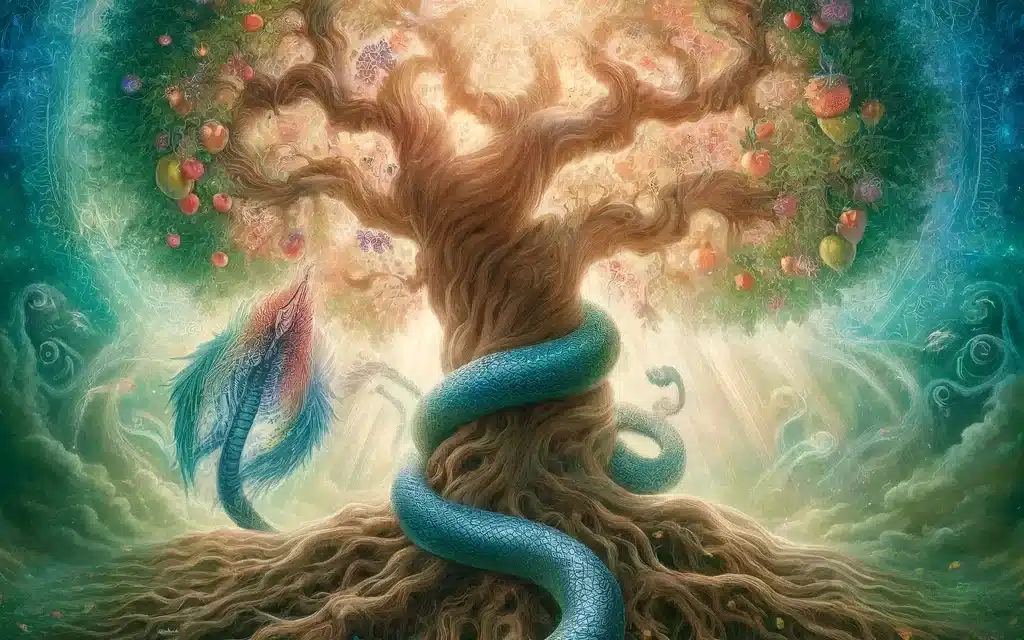Perhaps I don’t really understand what happened in the Garden of Eden. It’s always seemed a confusing story — Eve choosing the gift of knowledge by eating the symbolic fruit. Why do we attribute the light bringer of greater knowledge to the evil one? In ancient religions, the snake or serpent is not evil. In the Bible it is evil.
The symbols of the Tree of Life, the Serpent, and Kundalini encompass profound meanings and are integral to various spiritual traditions. These symbols represent concepts of creation, divine knowledge, spiritual awakening, and interconnectedness, offering rich insights into human consciousness and the universe.
The Tree of Life: A Symbol of Interconnectedness and Creation
The Tree of Life is a pervasive symbol found in many cultural mythologies and spiritual teachings across the world. Predominantly, it represents the unique interconnectedness of all life on our planet and often extends its meaning to the structure of the universe itself. It is depicted as a great and sacred tree whose roots delve deep into the earth, its trunk stands on terrestrial ground, and its branches stretch into the heavens, embodying the union between terrestrial and celestial life.
In the Kabbalistic tradition, the Tree of Life illustrates the path to enlightenment. It is depicted as a map of the universe and the psyche, comprising ten nodes or sephirot, each symbolizing different attributes like wisdom, strength, beauty, mercy, and justice, through which the divine energy flows within us and in the physical realm.
The Serpent: Knowledge, Danger, and Renewal
The serpent or snake is another universal emblem laden with ambiguity, often representing dual expressions of good and evil. In many cultures, the serpent stands for fertility, rebirth, and the cyclic nature of life due to its ability to shed its skin and emerge anew. This aspect makes the serpent a powerful symbol of healing and transformation—a creature that transcends the simple boundaries of good versus evil.
In Christianity, the serpent is traditionally linked to Satan and temptation, most famously in the Genesis story of Adam and Eve. This contrasts starkly with ancient Greek and Egyptian understandings, where serpents were seen as guardians of divine wisdom and healing—Asclepius, the Greek god of medicine, wielded a staff with a serpent entwined, which is still a symbol for medicine today.
Kundalini: The Serpent Power
Kundalini is conceptualized in Hindu philosophy as a form of divine feminine energy (or Shakti) located at the base of the spine, traditionally represented as a serpent coiled three and a half times around itself. This serpent lies dormant until awakened through spiritual disciplines such as yoga and meditation, at which point it ascends through the seven chakras aligned along the spine to the crown of the head.
The awakening of Kundalini is often described as a transformative experience that expands consciousness, brings profound insight, and gives rise to psychic abilities. However, without proper guidance, Kundalini awakening can also lead to overwhelming psychological challenges. Thus, it is revered and approached with respect in spiritual practices.
Interconnections: Tree of Life, Serpent, and Kundalini
Linking these symbols together, the Tree of Life bears a resemblance to the concept of the spine or the central axis (sushumna) in Kundalini yoga, where the serpent-like energy ascends, passing through various ‘branches’ or chakras, contributing to one’s spiritual growth. The serpent, coiled at the base of this tree, embodies potential energy (Kundalini) that, when properly harnessed, can lead to divine communion and enlightenment.
Each of these symbols—the Tree of Life with its expansive branches, the Serpent with its dual meanings of danger and healing, and Kundalini as a potent force of spiritual awakening—carry deep spiritual significance. They remind us of our own journey towards enlightenment, interconnectedness, and ultimately, our pursuit of the divine. Together, they provide a rich tapestry of symbolism that speaks to the perennial questions of human existence and our place in the cosmos. Through understanding and integrating these symbols into our lives, they guide us on a path of transformation and profound awakening, connecting the earthly with the divine.
The featured image:
Imagine a mystical scene where the Tree of Life, a universal symbol of interconnectedness and growth, stands tall and majestic. The tree’s roots are deep and widespread, and its branches reach upwards, sprawling towards the sky, intricately detailed with leaves and fruits that symbolize the various aspects of existence.
Intertwined with the tree is the Kundalini serpent, a symbol from Hindu philosophy representing divine feminine energy and spiritual enlightenment. The serpent is depicted as a coiling, vibrant entity that spirals up the trunk of the Tree of Life, embodying the rising of energy from the base of the human spine up through the crown, aligning with the tree’s growth towards the heavens.
The background is a harmonious blend of ethereal blues and greens, suggesting a peaceful yet powerful energy. Subtle lights and shadows play around the scene, highlighting the serpent’s scales and the textured bark of the tree, enhancing the mystical and spiritual ambiance.

